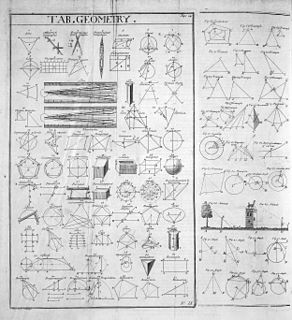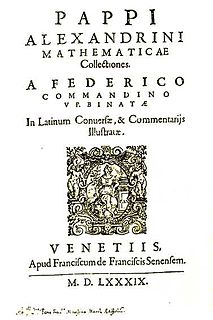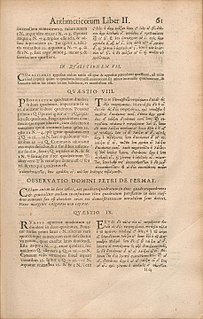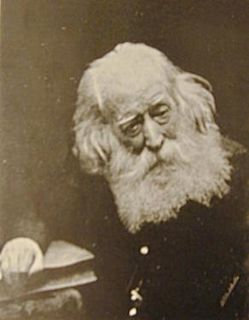In geometry, a square trisection is a type of dissection problem which consists of cutting a square into pieces that can be rearranged to form three identical squares.
Contents

In geometry, a square trisection is a type of dissection problem which consists of cutting a square into pieces that can be rearranged to form three identical squares.

The dissection of a square in three congruent partitions is a geometrical problem that dates back to the Islamic Golden Age. Craftsman who mastered the art of zellige needed innovative techniques to achieve their fabulous mosaics with complex geometric figures. The first solution to this problem was proposed in the 10th century AD by the Persian mathematician Abu'l-Wafa' (940-998) in his treatise "On the geometric constructions necessary for the artisan". [1] Abu'l-Wafa' also used his dissection to demonstrate the Pythagorean theorem. [2] This geometrical proof of Pythagoras' theorem would be rediscovered in the years 1835 - 1840 [3] by Henry Perigal and published in 1875. [4]
The beauty of a dissection depends on several parameters. However, it is usual to search for solutions with the minimum number of parts. Far from being minimal, the square trisection proposed by Abu'l-Wafa' uses 9 pieces. In the 14th century Abu Bakr al-Khalil gave two solutions, one of which uses 8 pieces. [5] In the late 17th century Jacques Ozanam came back to this issue [6] and in the 19th century, solutions using 8 and 7 pieces were found, including one given by the mathematician Édouard Lucas. [7] In 1891 Henry Perigal published the first known solution with only 6 pieces [8] (see illustration below). Nowadays, new dissections are still found [9] (see illustration above) and the conjecture that 6 is the minimal number of necessary pieces remains unproved.

Geometry arose as the field of knowledge dealing with spatial relationships. Geometry was one of the two fields of pre-modern mathematics, the other being the study of numbers (arithmetic).

The tangram is a dissection puzzle consisting of seven flat polygons, called tans, which are put together to form shapes. The objective is to replicate a pattern generally found in a puzzle book using all seven pieces without overlap. Alternatively the tans can be used to create original minimalist designs that are either appreciated for their inherent aesthetic merits or as the basis for challenging others to replicate its outline. It is reputed to have been invented in China sometime around the late 18th century and then carried over to America and Europe by trading ships shortly after. It became very popular in Europe for a time, and then again during World War I. It is one of the most widely recognized dissection puzzles in the world and has been used for various purposes including amusement, art, and education.

Straightedge and compass construction, also known as ruler-and-compass construction or classical construction, is the construction of lengths, angles, and other geometric figures using only an idealized ruler and a pair of compasses.

Angle trisection is a classical problem of straightedge and compass construction of ancient Greek mathematics. It concerns construction of an angle equal to one third of a given arbitrary angle, using only two tools: an unmarked straightedge and a compass.

Pappus of Alexandria was one of the last great Greek mathematicians of antiquity, known for his Synagoge (Συναγωγή) or Collection, and for Pappus's hexagon theorem in projective geometry. Nothing is known of his life, other than what can be found in his own writings: that he had a son named Hermodorus, and was a teacher in Alexandria.

Pseudomathematics, or mathematical crankery, is a mathematics-like activity that does not adhere to the framework of rigor of formal mathematical practice. Common areas of pseudomathematics are solutions of problems proved to be unsolvable or recognized as extremely hard by experts, as well as attempts to apply mathematics to non-quantifiable areas. A person engaging in pseudomathematics is called a pseudomathematician or a pseudomath. Pseudomathematics has equivalents in other scientific fields, such as pseudophysics, and overlaps with these to some extent.
A dissection puzzle, also called a transformation puzzle or Richter Puzzle, is a tiling puzzle where a set of pieces can be assembled in different ways to produce two or more distinct geometric shapes. The creation of new dissection puzzles is also considered to be a type of dissection puzzle. Puzzles may include various restraints, such as hinged pieces, pieces that can fold, or pieces that can twist. Creators of new dissection puzzles emphasize using a minimum number of pieces, or creating novel situations, such as ensuring that every piece connects to another with a hinge.
In geometry, a dissection problem is the problem of partitioning a geometric figure into smaller pieces that may be rearranged into a new figure of equal content. In this context, the partitioning is called simply a dissection. It is usually required that the dissection use only a finite number of pieces. Additionally, to avoid set-theoretic issues related to the Banach–Tarski paradox and Tarski's circle-squaring problem, the pieces are typically required to be well-behaved. For instance, they may be restricted to being the closures of disjoint open sets.

Early study of triangles can be traced to the 2nd millennium BC, in Egyptian mathematics and Babylonian mathematics. Trigonometry was also prevalent in Kushite mathematics. Systematic study of trigonometric functions began in Hellenistic mathematics, reaching India as part of Hellenistic astronomy. In Indian astronomy, the study of trigonometric functions flourished in the Gupta period, especially due to Aryabhata, who discovered the sine function. During the Middle Ages, the study of trigonometry continued in Islamic mathematics, by mathematicians such as Al-Khwarizmi and Abu al-Wafa. It became an independent discipline in the Islamic world, where all six trigonometric functions were known. Translations of Arabic and Greek texts led to trigonometry being adopted as a subject in the Latin West beginning in the Renaissance with Regiomontanus. The development of modern trigonometry shifted during the western Age of Enlightenment, beginning with 17th-century mathematics and reaching its modern form with Leonhard Euler (1748).

Pietro Mengoli was an Italian mathematician and clergyman from Bologna, where he studied with Bonaventura Cavalieri at the University of Bologna, and succeeded him in 1647. He remained as professor there for the next 39 years of his life.

In number theory, Fermat's Last Theorem states that no three positive integers a, b, and c satisfy the equation an + bn = cn for any integer value of n greater than 2. The cases n = 1 and n = 2 have been known since antiquity to have infinitely many solutions.
A timeline of algebra and geometry
This is a timeline of pure and applied mathematics history. It is divided here into three stages, corresponding to stages in the development of mathematical notation: a "rhetorical" stage in which calculations are described purely by words, a "syncopated" stage in which quantities and common algebraic operations are beginning to be represented by symbolic abbreviations, and finally a "symbolic" stage, in which comprehensive notational systems for formulas are the norm.

In mathematics, the Pythagorean theorem, or Pythagoras' theorem, is a fundamental relation in Euclidean geometry among the three sides of a right triangle. It states that the area of the square whose side is the hypotenuse is equal to the sum of the areas of the squares on the other two sides. This theorem can be written as an equation relating the lengths of the legs a, b and the hypotenuse c, often called the Pythagorean equation:

Fermat's right triangle theorem is a non-existence proof in number theory, published in 1670 among the works of Pierre de Fermat, soon after his death. It is the only complete proof given by Fermat. It has several equivalent formulations, one of which was stated in 1225 by Fibonacci. In its geometric forms, it states:

A Pythagorean tiling or two squares tessellation is a tiling of a Euclidean plane by squares of two different sizes, in which each square touches four squares of the other size on its four sides. Many proofs of the Pythagorean theorem are based on it, explaining its name. It is commonly used as a pattern for floor tiles. When used for this, it is also known as a hopscotch pattern or pinwheel pattern, but it should not be confused with the mathematical pinwheel tiling, an unrelated pattern.

Henry Perigal, Jr. FRAS MRI was a British stockbroker and amateur mathematician, known for his dissection-based proof of the Pythagorean theorem and for his unorthodox belief that the moon does not rotate.

In geometry, a hinged dissection, also known as a swing-hinged dissection or Dudeney dissection, is a kind of geometric dissection in which all of the pieces are connected into a chain by "hinged" points, such that the rearrangement from one figure to another can be carried out by swinging the chain continuously, without severing any of the connections. Typically, it is assumed that the pieces are allowed to overlap in the folding and unfolding process; this is sometimes called the "wobbly-hinged" model of hinged dissection.

IM 67118, also known as Db2-146, is an Old Babylonian clay tablet in the collection of the National Museum of Iraq that contains the solution to a problem in plane geometry concerning a rectangle with given area and diagonal. In the last part of the text the solution is proved correct by means of the Pythagorean theorem. The steps of the solution are believed to represent cut-and-paste geometry operations involving a diagram from which, it has been suggested, ancient Mesopotamians might, at an earlier time, have derived the Pythagorean theorem.

Geometric Exercises in Paper Folding is a book on the mathematics of paper folding. It was written by Indian mathematician T. Sundara Row, first published in India in 1893, and later republished in many other editions. Its topics include paper constructions for regular polygons, symmetry, and algebraic curves. According to historian of mathematics Michael Friedman, it became "one of the main engines of the popularization of folding as a mathematical activity".